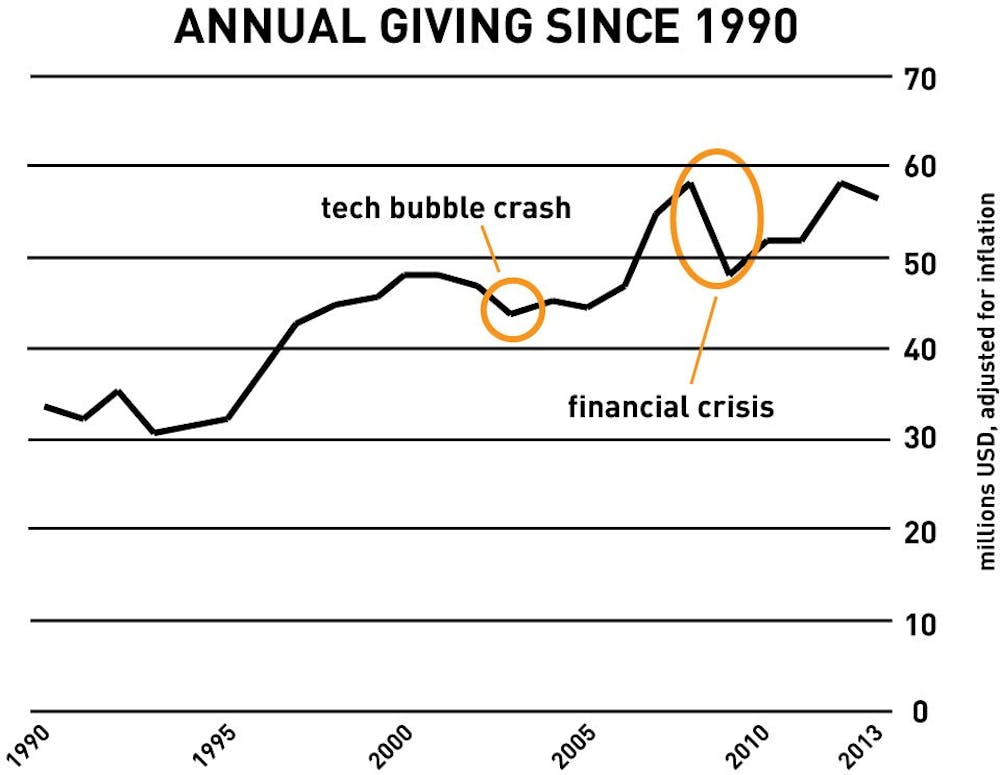The University’s last Annual Giving campaign raised $57,019,138,the second-highest total in the program’s history in nominal terms,just short of the $57,246,302 mark set the previous year. The 44,871 total donations set an all-time record, with 36,825 coming from undergraduate alumni.
“The remarkable thing about Annual Giving is that it starts from zero every year. It starts from zero in one class after another, and every single one of those classes has to perform in order for annual giving to be successful,” University President Christopher Eisgruber ’83 said in an interview with The Daily Princetonian last week.
Eisgruber also attributed some of this year’s success to a particularly strong final month of giving. Annual Giving is measured on a year-to-year basis according to the University’s fiscal schedule, which begins July 1.
“Different classes tend to have different patterns, almost like distance runners,” he said. “Some get out of the blocks early ... and some have a tendency to really turn it on at the end,” he said. “The numbers were very good as we hit June 15, but from June 15 to July 1 they went from very good to amazing.”
The Annual Giving campaign does not include large, one-off donations made to the University to fund specific projects. For instance, the$15 million donationmade byJeff Bezos ’86 and MacKenzie Bezos ’92to the new Princeton Neuroscience Institute did not enter in the Annual Giving campaign’s figures for the 2011-12 school year.
This year’s Annual Giving came on the heels of the University’s Aspire Campaign, a five-year fundraising push which began in 2007 and ended at the end of the 2011-12 school year, raising a total of $1.88 billion. Aspire appears to have succeeded in jumpstarting Annual Giving: After adjusting for inflation, the most successful Annual Giving campaigns bookended Aspire, in the 2007-08 and 2011-12 school years.
But despite the small drop-off from last year, this year's total is still the third-largest amount raised, in real terms, since 1990.
The steady increases in giving to the University over the past few years could mirror broadening confidence in market conditions. Annual Giving has closely tracked the performance of the stock market for the last 20 years, dipping slightly in response to the 2002 tech bubble and the recent financial crisis.
Eisgruber also acknowledged the influence of the economy on patterns of giving.
“There’s no doubt that the economy has something to do with it. We track giving overall at Princeton, and ironing out some small irregularities, the numbers do vary up and down with the economy,” he said.
Nonetheless, George Brakeley ’61, Executive Chair of Brakeley Briscoe Inc., said he believes the University’s ability to fundraise in times of financial stress distinguishes Princeton from many other institutions.
“Our 59, 60, 61 percent participation rate is rock solid. Even in the bad times, we’re right up there,” Brakeley said. “Giving to Princeton is a little different from other kinds of philanthropy. Giving to your local symphony is an intellectual decision; giving to Princeton is an emotional decision.”

The alumni participation rate has indeed hovered around 60 percent for the past 10 years, peaking at 61.3 percent in 2010-11. Following the financial crisis, participation dropped to 57.7 percent in 2008-09 but quickly rebounded to 60.8 percent the following year.
Brakeley, whose grandfather George Brakeley, Class of 1907, helped found the University’s Annual Giving campaign in 1939, attributed this resilience to Princeton’s unique culture of giving.
“We are inculcated with the culture of giving back to the University from day one,” he said. “They sat us down in Alexander Hall on the second day we were on campus and said to us, ‘You wouldn’t be here if it weren’t for generations of Princetonians. When you leave, you have the same obligation.’ ”
As a result, one of Princeton’s greatest fundraising strengths, according to Brakeley, is its ability to cultivate a spirit of giving among young alumni.
“I work with a lot of small, emerging colleges, as well as public, liberal arts universities ... and they are killing themselves to get to 25 percent or 30 percent [participation],” he said. “Our numbers are just off the charts.”
The participation figures of recent classes in Annual Giving campaigns seem consistent with Brakeley’s hypothesis. The youngest five classes achieved a 76.8 percent participation rate, ahead of the 71.9 percent of the oldest 10 classes. 90.1 percent of the Class of 2013 participated in the most recent Annual Giving campaign.
In total, undergraduate alumni accounted for just over 80 percent of all gifts to the Annual Giving campaign. By contrast, 3,097 graduate alumni donated a total of $1,859,038, another record high.
The Class of 1988, the 25th reunion class, achieved a participation rate of 77.6 percent and led all classes with a total of $9,001,988 in donations.








